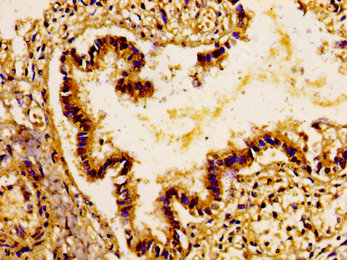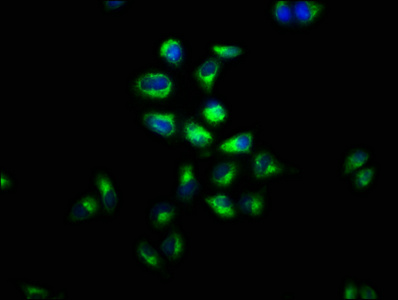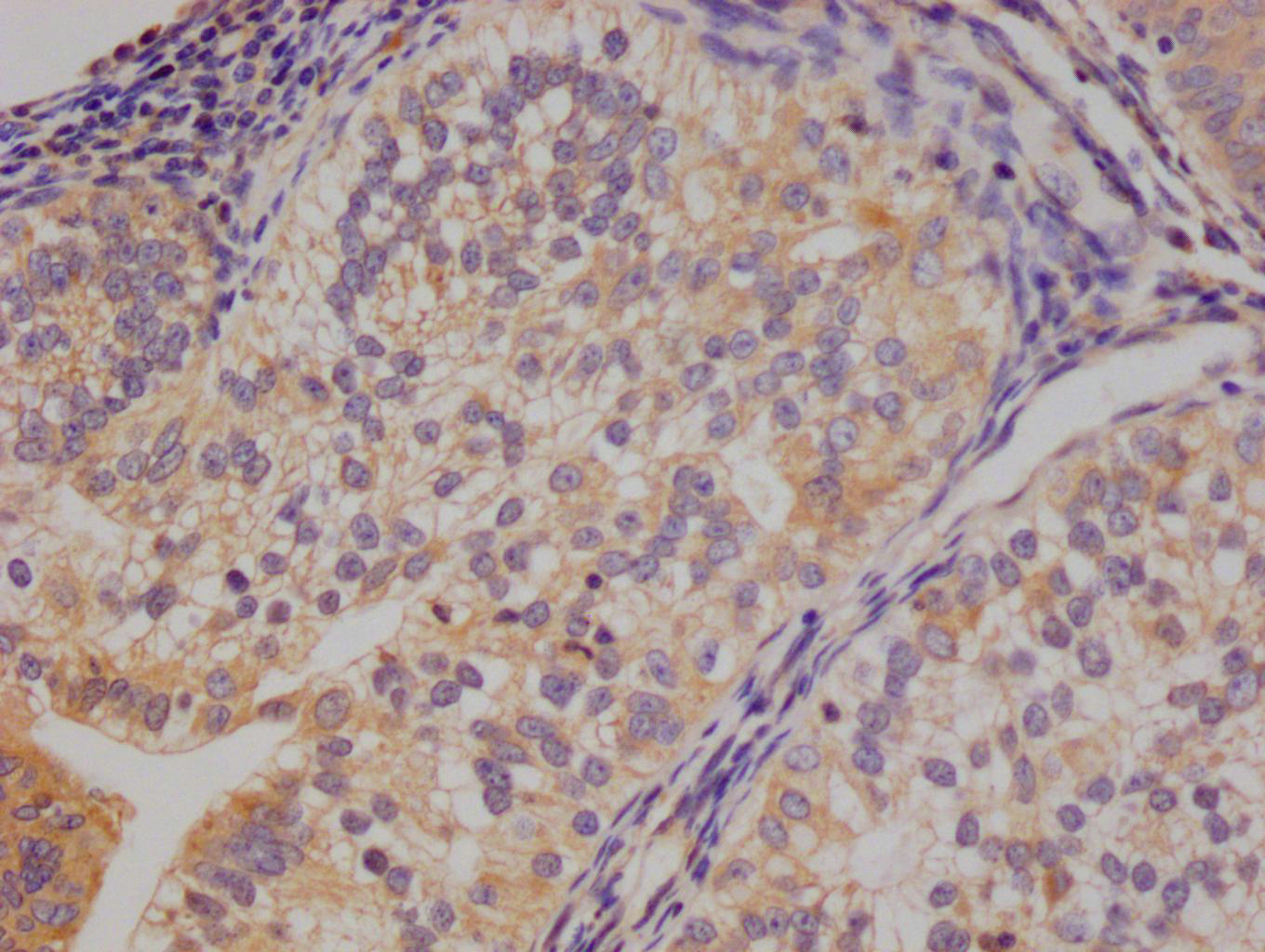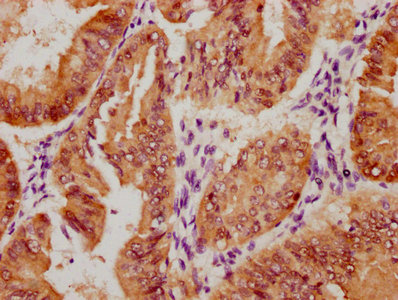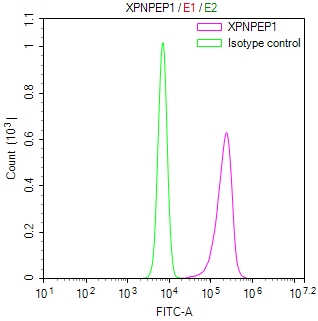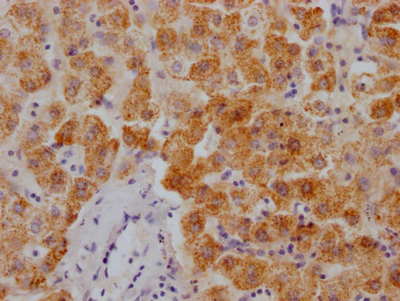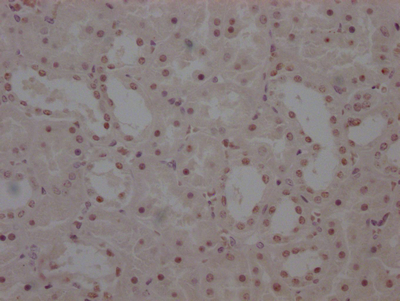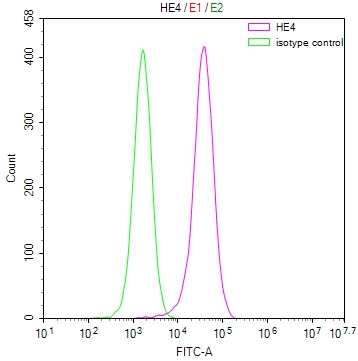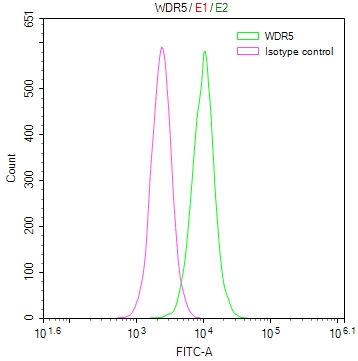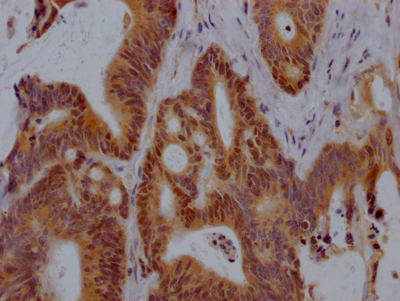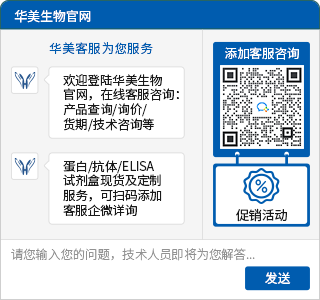LGR4 Antibody
-
货号:CSB-PA883618LA01HU
-
规格:¥440
-
促销:
-
图片:
-
IHC image of CSB-PA883618LA01HU diluted at 1:100 and staining in paraffin-embedded human lung tissue performed on a Leica BondTM system. After dewaxing and hydration, antigen retrieval was mediated by high pressure in a citrate buffer (pH 6.0). Section was blocked with 10% normal goat serum 30min at RT. Then primary antibody (1% BSA) was incubated at 4°C overnight. The primary is detected by a biotinylated secondary antibody and visualized using an HRP conjugated SP system.
-
Immunofluorescence staining of Hela cells with CSB-PA883618LA01HU at 1:100, counter-stained with DAPI. The cells were fixed in 4% formaldehyde, permeabilized using 0.2% Triton X-100 and blocked in 10% normal Goat Serum. The cells were then incubated with the antibody overnight at 4°C. The secondary antibody was Alexa Fluor 488-congugated AffiniPure Goat Anti-Rabbit IgG(H+L).
-
-
其他:
产品详情
-
产品名称:Rabbit anti-Homo sapiens (Human) LGR4 Polyclonal antibody
-
Uniprot No.:Q9BXB1
-
基因名:
-
别名:BNMD17 antibody; G protein coupled receptor 48 antibody; G-protein coupled receptor 48 antibody; GPR48 antibody; Leucine-rich repeat-containing G protein-coupled receptor 4 antibody; Leucine-rich repeat-containing G-protein coupled receptor 4 antibody; LGR4 antibody; LGR4_HUMAN antibody
-
宿主:Rabbit
-
反应种属:Human
-
免疫原:Recombinant Human Leucine-rich repeat-containing G-protein coupled receptor 4 protein (234-365AA)
-
免疫原种属:Homo sapiens (Human)
-
标记方式:Non-conjugated
本页面中的产品,LGR4 Antibody (CSB-PA883618LA01HU),的标记方式是Non-conjugated。对于LGR4 Antibody,我们还提供其他标记。见下表:
-
克隆类型:Polyclonal
-
抗体亚型:IgG
-
纯化方式:>95%, Protein G purified
-
浓度:It differs from different batches. Please contact us to confirm it.
-
保存缓冲液:Preservative: 0.03% Proclin 300
Constituents: 50% Glycerol, 0.01M PBS, pH 7.4 -
产品提供形式:Liquid
-
应用范围:ELISA, IHC, IF
-
推荐稀释比:
Application Recommended Dilution IHC 1:20-1:200 IF 1:50-1:200 -
Protocols:
-
储存条件:Upon receipt, store at -20°C or -80°C. Avoid repeated freeze.
-
货期:Basically, we can dispatch the products out in 1-3 working days after receiving your orders. Delivery time maybe differs from different purchasing way or location, please kindly consult your local distributors for specific delivery time.
相关产品
靶点详情
-
功能:Receptor for R-spondins that potentiates the canonical Wnt signaling pathway and is involved in the formation of various organs. Upon binding to R-spondins (RSPO1, RSPO2, RSPO3 or RSPO4), associates with phosphorylated LRP6 and frizzled receptors that are activated by extracellular Wnt receptors, triggering the canonical Wnt signaling pathway to increase expression of target genes. In contrast to classical G-protein coupled receptors, does not activate heterotrimeric G-proteins to transduce the signal. Its function as activator of the Wnt signaling pathway is required for the development of various organs, including liver, kidney, intestine, bone, reproductive tract and eye. May also act as a receptor for norrin (NDP), such results however require additional confirmation in vivo. Required during spermatogenesis to activate the Wnt signaling pathway in peritubular myoid cells. Required for the maintenance of intestinal stem cells and Paneth cell differentiation in postnatal intestinal crypts. Acts as a regulator of bone formation and remodeling. Involved in kidney development; required for maintaining the ureteric bud in an undifferentiated state. Involved in the development of the anterior segment of the eye. Required during erythropoiesis. Also acts as a negative regulator of innate immunity by inhibiting TLR2/TLR4 associated pattern-recognition and proinflammatory cytokine production. Plays an important role in regulating the circadian rhythms of plasma lipids, partially through regulating the rhythmic expression of MTTP.
-
基因功能参考文献:
- Loss of LGR4 abrogated RSPO3-regulated osteogenesis and RSPO3-induced ERK1/2 signalling inhibition. PMID: 28220828
- Luciferase reporter assay was performed to confirm that LGR4 is a direct target gene of miR-137 with a potential binding site in the 3'UTR of LGR4. PMID: 29786747
- the host protein leucine-rich repeat-containing G protein-coupled receptor 4 (Lgr4) is essential for VSV and VSV-G pseudotyped lentivirus (VSVG-LV) to infect susceptible cells. PMID: 28842478
- High LGR4 expression is associated with osteoarthritis. PMID: 28777797
- Data (including data from studies using transgenic/knockout mice) suggest that LGR4 is key protein necessary for prostate cancer epithelial-mesenchymal transition and metastasis; LGR4 expression is elevated in human prostate cancer cell lines with metastatic potential; LGR4 silencing in prostate cancer cell line impairs cell migration and invasion without affecting cell proliferation. PMID: 28768769
- LGR4 is another receptor for RANKL. LGR4 competes with RANK to bind RANKL and suppresses canonical RANK signaling during osteoclast differentiation. PMID: 27064449
- The LGR4 A750T variant is correlated with central obesity-related characteristics in young subjects. PMID: 27925416
- Lgr4 is a critical positive factor for skin tumorigenesis by mediating the activation of MEK1/ERK1/2 and Wnt/beta-catenin pathways. PMID: 27693558
- miR-34a gene expression upregulation inhibits ARPE-19 cell proliferation, migration and adhesion partly by suppressing LGR4 expression. PMID: 27977785
- Lgr4 activates Jmjd2a/AR signaling pathway to promote interaction AR with PSA promoter, causing reduction of prostate cancer apoptosis and cell cycle arrest. PMID: 27743893
- A mechanistic understanding of RANKL-LGR4 interaction has provided new insight into LGR4 mediated RANKL signaling in osteoporosis and other diseases PMID: 27178473
- miR-218 directly targets LGR4 and modulated the PI3K/Akt and Wnt/beta-catenin pathways in the LNCaP-IL-6+ cells. PMID: 26986507
- LGR4 promotes tumorigenesis of prostate cancer via PI3K/Akt signaling pathway. PMID: 25636507
- These findings suggest that aberrant RSPO3-LGR4 signaling potentially acts as a driving mechanism in the aggressiveness of Keap1-deficient lung ADs. PMID: 25531322
- the LGR4-Rspo1 complex crystal structure shows divergent mechanisms of ligand recognition by leucine-rich repeat G-protein-coupled receptors PMID: 25480784
- our results suggest a previously unknown Stat3-LGR4 molecular network, which may control osteosarcoma development and progression PMID: 24455684
- RSPO-LGR4 not only induces the clearance of RNF43/ZNRF3 to increase Wnt receptor levels but also recruits IQGAP1 into the Wnt signaling complex. PMID: 24639526
- Lgr4, which regulates eye, kidney, testis, ovary, and uterine organ development as well as mental development through genetic and epigenetic surveillance, is a novel candidate gene for the pathogenesis of AGR syndrome PMID: 24519938
- GPR48 overexpression promotes cancer cell proliferation via activation of Wnt signaling. PMID: 24083742
- Lgr4 overexpression promoted glioma cell proliferation through activation of Wnt signaling. PMID: 24083766
- Upregulation of GPR48 resulted in increased phosphorylation of glycogen synthase kinase 3beta. PMID: 23803691
- A functional low-frequency human LGR4 variant (A750T) has been associated with body mass index in a Chinese obese-versus-control study. PMID: 24212090
- Multi-functional norrin is a ligand for the LGR4 receptor. PMID: 23444378
- the c.376C>T mutation is associated with low BMD and osteoporotic fractures, electrolyte imbalance, late onset of menarche, reduced testosterone levels, and an increased risk of squamous cell carcinoma of the skin and biliary tract cancer PMID: 23644456
- Lgr4/Gpr48 plays a critical role in modulating the TLR2/4 signaling pathway and represents a useful therapeutic approach of targeting Lgr4/Gpr48 in TLR2/4-associated septic shock and autoimmune diseases. PMID: 23589304
- R-Spondin potentiates Wnt/beta-catenin signaling through orphan receptors LGR4 and LGR5 PMID: 22815884
- LGR4 and LGR5 bind the R-spondins with high affinity and mediate the potentiation of Wnt/beta-catenin signaling by enhancing Wnt-induced LRP6 phosphorylation. PMID: 21693646
- GPR48 may play an important role in invasiveness and metastasis of carcinoma and might represent a potential prognostic marker or therapeutic target. PMID: 17178856
- Testicular efferent ducts in the mutant mouse are dramatically shortened and less convoluted than in the wild-type animal, providing an explanation to the phenotype observed in LGR4KO. PMID: 19301269
- Data show that GPR48 shRNA can inhibit in vitro invasion and in vivo metastasis of HeLa cells efficiently. PMID: 19550120
显示更多
收起更多
-
相关疾病:Osteoporosis (OSTEOP)
-
亚细胞定位:Cell membrane; Multi-pass membrane protein.
-
蛋白家族:G-protein coupled receptor 1 family
-
组织特异性:Expressed in multiple steroidogenic tissues: placenta, ovary, testis and adrenal. Expressed also in spinal cord, thyroid, stomach, trachea, heart, pancreas, kidney, prostate and spleen.
-
数据库链接:
HGNC: 13299
OMIM: 166710
KEGG: hsa:55366
STRING: 9606.ENSP00000368516
UniGene: Hs.502176
Most popular with customers
-
-
Phospho-YAP1 (S127) Recombinant Monoclonal Antibody
Applications: ELISA, WB, IHC
Species Reactivity: Human
-
-
-
-
-
-


